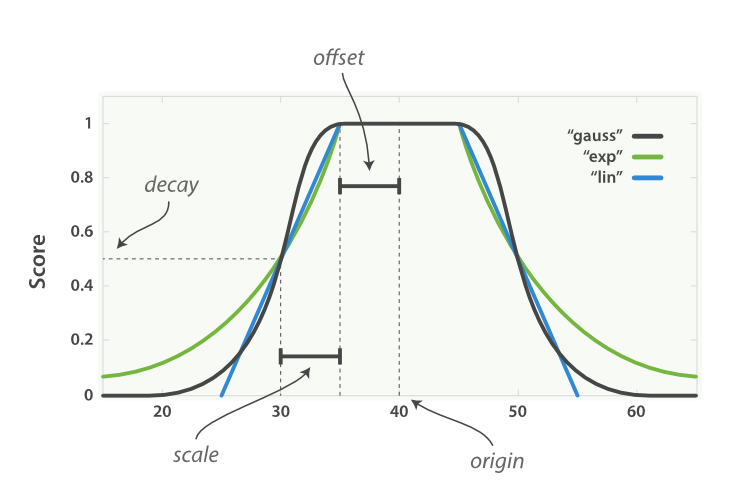
The Closer, The Better
Many variables could influence the user’s choice of vacation home. Maybe she would like to be close to the center of town, but perhaps would be willing to settle for a place that is a bit farther from the center if the price is low enough. Perhaps the reverse is true: she would be willing to pay more for the best location.
If we were to add a filter that excluded any vacation homes farther than 1 kilometer from the center, or any vacation homes that cost more than £100 a night, we might exclude results that the user would consider to be a good compromise.
The function_score query gives us the ability to trade off one sliding scale
(like location) against another sliding scale (like price), with a group of
functions known as the decay functions.
The three decay functions—called linear, exp, and gauss—operate on numeric fields, date fields, or lat/lon geo-points. All three take
the same parameters:
origin-
The central point, or the best possible value for the field. Documents that fall at the
originwill get a full_scoreof1.0. scale-
The rate of decay—how quickly the
_scoreshould drop the further from theoriginthat a document lies (for example, every £10 or every 100 meters). decay-
The
_scorethat a document atscaledistance from theoriginshould receive. Defaults to0.5. offset-
Setting a nonzero
offsetexpands the central point to cover a range of values instead of just the single point specified by theorigin. All values in the range-offset ⇐ origin ⇐ +offsetwill receive the full_scoreof1.0.
The only difference between these three functions is the shape of the decay curve. The difference is most easily illustrated with a graph (see Decay function curves).

The curves shown in Decay function curves all have their origin—the
central point—set to 40. The offset is 5, meaning that all values in
the range 40 - 5 ⇐ value ⇐ 40 + 5 are treated as though they were at the
origin—they all get the full score of 1.0.
Outside this range, the score starts to decay. The rate of decay is
determined by the scale (which in this example is set to 5), and the
decay (which is set to the default of 0.5). The result is that all three
curves return a score of 0.5 at origin +/- (offset + scale), or at points
30 and 50.
The difference between linear, exp, and gauss is the shape of the curve at other points in the range:
-
The
linearfuntion is just a straight line. Once the line hits zero, all values outside the line will return a score of0.0. -
The
exp(exponential) function decays rapidly, then slows down. -
The
gauss(Gaussian) function is bell-shaped—it decays slowly, then rapidly, then slows down again.
Which curve you choose depends entirely on how quickly you want the _score
to decay, the further a value is from the origin.
To return to our example: our user would prefer to rent a vacation home close
to the center of London ({ "lat": 51.50, "lon": 0.12}) and to pay no more
than £100 a night, but our user considers price to be more important than
distance. We could write this query as follows:
GET /_search
{
"query": {
"function_score": {
"functions": [
{
"gauss": {
"location": { (1)
"origin": { "lat": 51.5, "lon": 0.12 },
"offset": "2km",
"scale": "3km"
}
}
},
{
"gauss": {
"price": { (2)
"origin": "50", (3)
"offset": "50",
"scale": "20"
}
},
"weight": 2 (4)
}
]
}
}
}-
The
locationfield is mapped as ageo_point. -
The
pricefield is numeric. -
See Understanding the price Clause for the reason that
originis50instead of100. -
The
priceclause has twice the weight of thelocationclause.
The location clause is easy to understand:
-
We have specified an
originthat corresponds to the center of London. -
Any location within
2kmof theoriginreceives the full score of1.0. -
Locations
5km(offset + scale) from the centre receive a score of0.5.
Understanding the price Clause
The price clause is a little trickier. The user’s preferred price is
anything up to £100, but this example sets the origin to £50. Prices can’t be
negative, but the lower they are, the better. Really, any price between £0 and
£100 should be considered optimal.
If we were to set the origin to £100, then prices below £100 would receive a
lower score. Instead, we set both the origin and the offset to £50. That
way, the score decays only for any prices above £100 (origin + offset).
|
Tip
|
The |